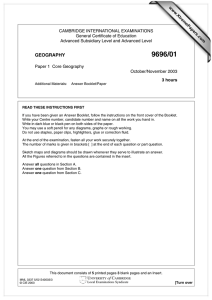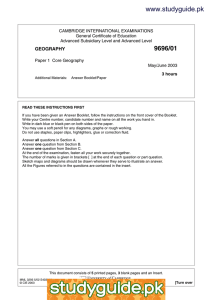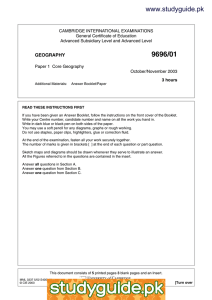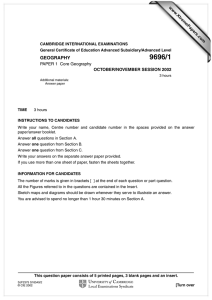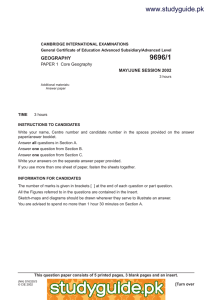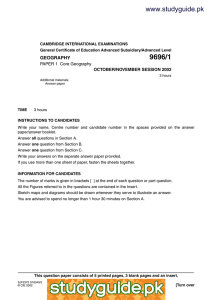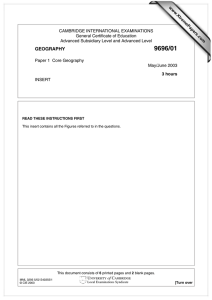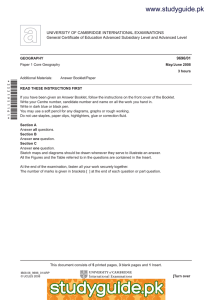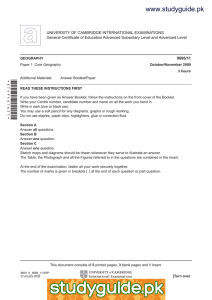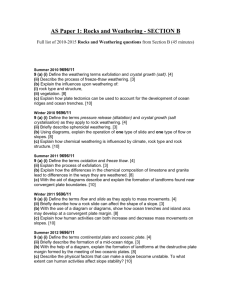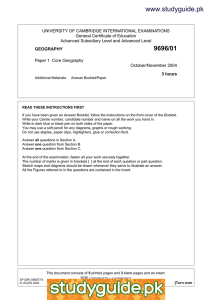CAMBRIDGE INTERNATIONAL EXAMINATIONS General Certificate of Education www.XtremePapers.com
advertisement
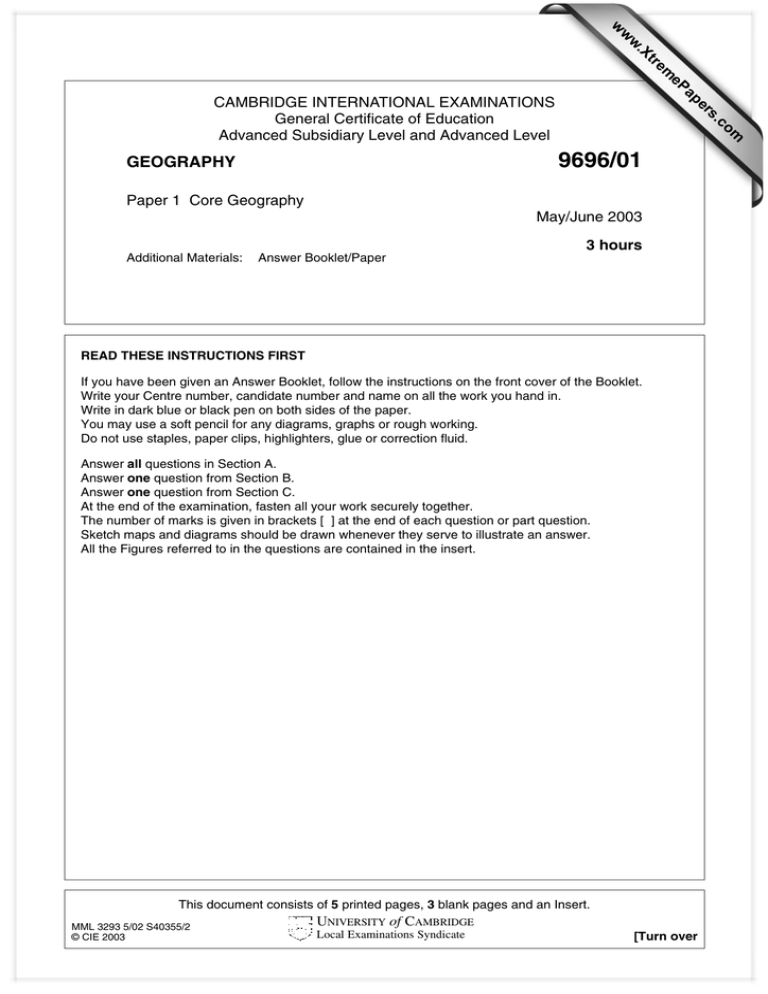
w w ap eP m e tr .X w om .c s er CAMBRIDGE INTERNATIONAL EXAMINATIONS General Certificate of Education Advanced Subsidiary Level and Advanced Level 9696/01 GEOGRAPHY Paper 1 Core Geography May/June 2003 3 hours Additional Materials: Answer Booklet/Paper READ THESE INSTRUCTIONS FIRST If you have been given an Answer Booklet, follow the instructions on the front cover of the Booklet. Write your Centre number, candidate number and name on all the work you hand in. Write in dark blue or black pen on both sides of the paper. You may use a soft pencil for any diagrams, graphs or rough working. Do not use staples, paper clips, highlighters, glue or correction fluid. Answer all questions in Section A. Answer one question from Section B. Answer one question from Section C. At the end of the examination, fasten all your work securely together. The number of marks is given in brackets [ ] at the end of each question or part question. Sketch maps and diagrams should be drawn whenever they serve to illustrate an answer. All the Figures referred to in the questions are contained in the insert. This document consists of 5 printed pages, 3 blank pages and an Insert. MML 3293 5/02 S40355/2 © CIE 2003 UNIVERSITY of CAMBRIDGE Local Examinations Syndicate [Turn over 2 Section A Answer all the questions in this section. All questions carry 10 marks. Atmosphere and weather 1 Fig. 1 shows the effects of a cold ocean current upon the formation of fog and a temperature height diagram for the area where the fog has formed. (a) (b) (i) Describe how the temperature changes with height. [2] (ii) Identify the feature marked as A. [1] (i) Name the type of fog shown in the diagram. [1] (ii) Explain how and why the fog has formed over the ocean area. [6] Rocks and weathering 2 Fig. 2 shows types and processes of mass movement. (a) (i) Which type of mass movement has both the fastest rate of movement and the greatest water content? [1] (ii) Which type of mass movement has the slowest rate of movement and the lowest water content? [1] (b) Briefly describe the differences between flow and slide. [3] (c) Describe and explain the occurrence of one of the types of mass movement shown on Fig. 2. [5] Population change 3 Fig. 3A shows the age/sex pyramid for Singapore in 2000 and Figs 3B and 3C show the projected age/sex pyramids for 2025 and 2050. (a) (i) Identify two features of the pyramid in Fig. 3A. [2] (ii) Giving evidence from Figs 3B and 3C, describe the changes in population structure projected for Singapore by 2050. [3] (b) What are the possible consequences, for a country, of having an ageing population? 9696/01/M/J/03 [5] 3 Population change/Settlement dynamics 4 Table 1 gives information about the total urban population and the percentage urban population in more developed regions and less developed regions in 1970 and 1994, together with projections for 2025. (a) (i) For the period 1970-1994, name the part of the world which experienced: A the least increase in total urban population, B the greatest increase in total urban population, C the least percentage change in urban population, D the greatest percentage change in urban population. [2] (ii) Compare the 2025 projected percentage urban population for the more developed regions with that for the less developed regions. [3] (b) Suggest reasons for the high rates of urbanisation in many less economically developed countries (LEDCs). [5] Settlement dynamics 5 Fig. 4 shows the layout of Brasília, the capital city built in Brazil’s interior. (a) Describe the main features of the city’s layout. [5] (b) Brasília was planned not to be segregated socially. Suggest reasons why it is more usual for residential segregation to develop within urban areas. [5] 9696/01/M/J/03 [Turn over 4 Section B: The Physical Core Answer one question from this section. All questions carry 25 marks. Hydrology and fluvial geomorphology 6 (a) (i) Define the terms throughflow and groundwater flow (baseflow). [4] (ii) Briefly describe the process of interception and give reasons why it is of importance in the hydrological system. [3] (b) Briefly explain how each of the following may influence the hydrograph of a river: (i) drainage basin shape, (ii) geology, (iii) rainfall intensity, (iv) drainage density. [8] (c) Explain how river floods might be predicted. Giving examples, describe the methods which may be used to reduce the effects of flooding. [10] Atmosphere and weather 7 (a) (b) (i) Define the terms evaporation and condensation. [4] (ii) Give three conditions necessary for high evaporation rates. [3] (i) Draw a labelled diagram to show the greenhouse effect in the earth’s atmosphere. [3] (ii) Describe what is meant by greenhouse gases and explain their influence on the temperature of the atmosphere. [5] (c) Explain how clouds are formed. Why do only some clouds produce rainfall? [10] Rocks and weathering 8 (a) (b) (i) Define the terms physical (mechanical) weathering and chemical weathering. [4] (ii) Briefly describe one chemical weathering process. [3] (i) Draw a labelled diagram to show sea floor spreading. [4] (ii) Describe one landform that is associated with sea floor spreading. [4] (c) Describe the chemical composition and physical properties of granite and explain how these affect its weathering and erosion. [10] 9696/01/M/J/03 5 Section C: The Human Core Answer one question from this section. All questions carry 25 marks. Population change 9 Fig. 5 shows the demographic transition model. (a) Describe and explain the population trends for one country in Stage 2 of the model. [7] (b) What social and economic factors help explain the population trends experienced by some more economically developed countries (MEDCs) in Stage 4? [8] (c) To what extent can the demographic transition model help us to understand future population trends in less economically developed countries (LEDCs)? [10] Population change 10 (a) (i) Give the meaning of the term population ceiling. [3] (ii) Explain two ways in which a growing population may adjust to the population ceiling. [4] (b) Suggest reasons why the concept of a population ceiling may be of limited usefulness in reality. [8] (c) Why have many attempts at reducing the birth rate in less economically developed countries (LEDCs) had only limited success? [10] Settlement dynamics 11 (a) (i) Give two reasons for the intense competition for land near the centres of towns and cities. (ii) What evidence may be seen in the urban landscape of this competition for central space? [7] (b) Using examples, describe the attempts that have been made in more economically developed countries (MEDCs) to control the spread of urban areas. [8] (c) Choose one rural settlement or rural area which is undergoing change. How positive are the changes that have taken place there recently? [10] 9696/01/M/J/03 6 BLANK PAGE 9696/01/M/J/03 7 BLANK PAGE 9696/01/M/J/03 8 BLANK PAGE Copyright Acknowledgements: Table 1 Figure 4 M Pacione. Geography Vol. 86 Part 3. Published by The Geographical Association. © United Nations. John Dickenson et al. A Geography of the Third World. Published by Routledge. © John Dickenson. Cambridge International Examinations has made every effort to trace copyright holders, but if we have inadvertently overlooked any we will be pleased to make the necessary arrangements at the first opportunity. 9696/01/M/J/03
